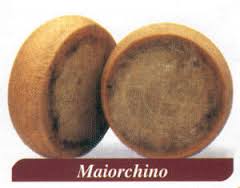Dairy cycle (Maiorchino)
Description
Dairy cycle (Maiorchino)
Mallorcan

----------------
Technical data sheets prepared by: Region of Sicily - Department of cultural heritage and Sicilian identity - CRicd: Regional center for inventory, cataloging and documentation and Sicilian regional film library
1st Dairy Cycle (Maiorchino)
No. Prog.
24
Bene
Dairy cycle (Maiorchino)
Book
REI - Book of celebrations
Approval date
25-01-2006
Category
Knows
Province
Messina
Location
Peloritani Mountains
Common
Local denomination
Chronological News
It is believed that the Maiorchino was born at the beginning of the seventeenth century, together with the traditional "Sagra della Maiorchina".
Maiorchino is very famous for its artisanal production: as early as 1933 a publication by Carmelo Campisi, entitled Sheep and Pecorino of Sicily, illustrated the techniques.
recurrence
-
Data
opportunity
Function
Actors
Participants
Description
Maiorchino is a typical and precious Sicilian hard cheese, produced above all in Novara di Sicilia.
Each form of Maiorchino is the result of a long and patient procedure, to be followed carefully.
The taste is particularly spicy and very strong, it is produced only from February to June. It starts by filtering raw sheep's milk, to which mixed milk is sometimes added (goat milk for example), collecting everything in a copper container called quarry. After about an hour the curd is broken with a wooden tool (a pitcher) and put it back on the fire, waiting for it to settle on the bottom. Then, when it has become cold, it is collected manually and given a spherical shape before being put to rest in the polite (wooden mold) and then on brick (wooden table). Thus begins the very delicate drilling phase, essential to separate the whey from what will be the final product. The drilling, however, is still done as in the past, that is with the threaten, an iron needle that serves to break the air bubbles that form inside the cheese. In fact, as the cheese deflates, it is gently pressed in order to be compacted; this is the most delicate phase of the entire production process. This is followed by the salting of the Maiorchino, which takes place dry and requires a period of twenty to thirty days. Finally, the aging of Maiorchino is very complex and divided into various phases: for the first two months the cheese is cleaned, rubbed and turned over; from the third month onwards, the treatment with olive oil begins. The average curing time required to obtain a really good Maiorchino is between six and eight months. The seasoning takes place in stone buildings, sometimes underground, cool and humid, equipped with wooden shelves and can last up to twenty-four months. The shape is cylindrical, the rind is amber yellow tending to brown as it ages, the paste is white tending to straw. In the mouth, the herbaceous, floral and fruity aromas characterize this cheese with a strong and spicy taste, especially if aged.
Catalog Sheet
REFERENCES
Campisi, Carmel. 1933. Sheep and Pecorino of Sicily: breeding, shearing, milking, making pecorino cheeses. Catania: F. Battiato.
Giacomara, Mario. 2006, The Madonie shepherds: environment, techniques, society. Palermo: Ignazio Buttitta Foundation.
Giallombardo, Fatima. 2003. The table, the altar, the road. Food scenarios in Sicily. Palermo: Sellerio.
Sitography
Filmography
Discography
Footnotes
The Maiorchino is the protagonist of an ancient game, dating back to the seventeenth century, an unmissable event for the entire population of Novara di Sicilia and the province of Messina. The game consists in rolling a wheel of the famous cheese through the narrow streets of the historic center of Novara di Sicilia, for about two kilometers. Teams of three players attempt to win the coveted competition by leading the form to the finish line with the fewest number of throws. To cast the forms, which weigh about ten kilos, have a diameter of thirty-five centimeters and a thickness of twelve, the teams help each other with alewd, a very sturdy lace that gives greater strength to the launch. Traditionally, the final of the tournament always takes place on Shrove Tuesday, turning into a party for the whole town: a real sheepfold is set up in the square, where peasants in traditional clothes prepare typical dishes.
Card Author: Paola Barbata
Go to Google Maps
Send a notice to the publisher
[contact-form-7 id="18385"]


